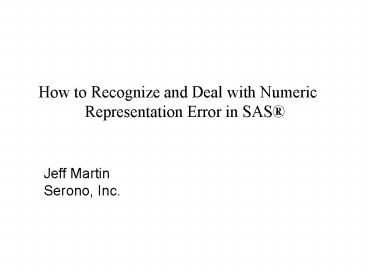How to Recognize and Deal with Numeric Representation Error in SAS - PowerPoint PPT Presentation
1 / 23
Title:
How to Recognize and Deal with Numeric Representation Error in SAS
Description:
How do computers store numeric data? Overview of floating point binary ... VAX/VMS. 1 bit for the sign. 55 bits for the mantissa. 8 bits for the exponent ... – PowerPoint PPT presentation
Number of Views:50
Avg rating:3.0/5.0
Title: How to Recognize and Deal with Numeric Representation Error in SAS
1
- How to Recognize and Deal with Numeric
Representation Error in SAS
Jeff Martin Serono, Inc.
2
Outline
- How do computers store numeric data?
- Overview of floating point binary
- How does SAS store numeric data?
- What is numeric representation error?
- How can you deal with it?
3
Why Worry About This?
- Brief example
- data temp
- initial_val0.3
- other_val0.13
- differenceinitial_val-other_val
- run
- proc print noobs
- run
4
Why Worry About This?
- Output
- initial_ other_
- val val difference
- 0.3 0.3 -5.5511E-17
5
How Do Computers Store Numbers?
- Integer
- Decimal or Packed Decimal
- Floating Point Binary
6
How Do Computers Store Numbers?
- Integer
- Pros
- Simple, straightforward usage and computations
- Cons
- Not practical - unable to store fractional values
7
How Do Computers Store Numbers?
- Decimal or Packed Decimal
- Pros
- Able to store fractional values
- Cons
- Hardware needs to provide storage for large
decimals - Loss of computational efficiency
8
How Do Computers Store Numbers?
- Floating Point Binary
- (used by the SAS System)
- Pros
- Able to store fractional values and integer
values - Efficient for computing use of binary numbers
- Cons
- Subject to representation error
9
How Does Floating Point Binary Work?
- Number values are stored as four types of
information - Sign
- Mantissa
- Base
- Exponent
10
How Does Floating Point Binary Work?
- Example
- .4321 10 4
- sign mantissa base
exponent
11
How Does SAS Store Numbers?
- Each numeric value is stored in up to 64 bits
(binary digits) or 8 bytes (groups of 8 bits). - Different operating systems may distribute the
bits differently and have different base value
(usually 2 or 16). - Windows/DOS/Unix
- 1 bit for the sign,
- 52 bits for the mantissa
- 11 bits for the exponent
- VAX/VMS
- 1 bit for the sign
- 55 bits for the mantissa
- 8 bits for the exponent
12
How Does SAS Store Numbers?
- Example
- SEEEEEEE EEEEMMMM MMMMMMMM MMMMMMMM
- byte 1 byte 2 byte 3 byte 4
- MMMMMMMM MMMMMMMM MMMMMMMM MMMMMMMM
- byte 5 byte 6 byte 7 byte 8
- S sign
- E exponent
- M mantissa
13
The Problem
- Computers are limited in that they need to use a
finite set of numbers to represent infinite real
numbers (note limited bits in previous slide) - Affects the amount of precision available in
which to store the numeric value - Computers use binary arithmetic instead of
decimal arithmetic
14
The Result
- Values that do not have an exact binary
representation (ie, 0.1, 1/3, etc.) must be
approximated - Associative law may not apply (ie, (ab)c may
not equal a(bc)) - May yield unexpected results
- Use of different procedures or orders of
operations may yield different numeric results
(may cause suspicion of programming error)
15
What do numeric values in SAS really look like?
- Numeric values in SAS are displayed using
formatted values rather than the floating point
representations - Even using maximum decimal places will not
display the full value - Only HEX16. format displays the exact value of a
numeric variable - Can help track down representation error
16
What do numeric values in SAS really look like?
- Example
- data temp
- initial_val0.3
- other_val0.13
- differenceinitial_val-other_val
- initial_val_hexput(initial_val,hex16.)
- other_val_hexput(other_val,hex16.)
- run
- proc print noobs
- run
17
What do numeric values in SAS really look like?
- Output
- initial_ other_
- val val difference
- 0.3 0.3 -5.5511E-17
- initial_val_hex other_val_hex
- 3FD3333333333333 3FD3333333333334
18
What can you do?
- Rounding the numbers
- Need to determine the number of significant
digits to round to - Can use the SAS ROUND function
19
How the ROUND function works
- Scales the value based on the round off unit
- If the value is positive, adds a constant of
.500000000001 and lowers the result to the
nearest integer - If the value is negative, subtracts constant of
.500000000001 and raises the result to the
nearest integer - Scales the value back based on the round off unit
20
What else can you do?
- FUZZ the comparisons
- Determine an acceptable difference between two
values - If the difference is smaller than the acceptable
difference, the two values are considered equal
21
More on fuzzing
- Options in PROC COMPARE allow you to set a fuzz
factor when comparing datasets. By using the
CRITERION and FUZZ options, you can consider
values within a specified difference to be equal. - proc compare basebasedata comparecompdata
- criterion.000000000001 fuzz.000000000001
- run
- Can set up a statement in conditionals
- If abs(a-b) le .000000000001 then do
22
Conclusions
- Numeric representatation error is a consequence
of working in a computing environment - While there is no definitive solution to the
problem, methods exist to adjust for it and still
get the most out of your data - Recognizing that it exists is a step forward in
dealing with it
23
References
- Numeric Precision 101, available from
- http//support.sas.com/techsup/technote/ts654.html
- Dealing With Numeric Representation Error,
available from - http//support.sas.com/techsup/technote/ts230.html
- Numeric Data in SAS Guidelines for Storage and
Display - Paul Gorrell
- Social Scientific Systems, Inc.
- Silver Spring, MD































